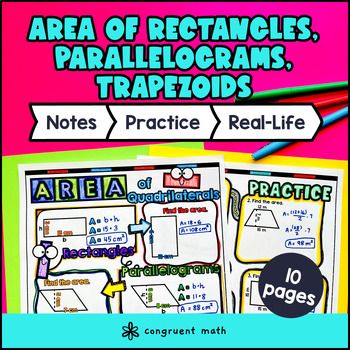Want more ideas and freebies?
Get my free resource library with digital & print activities—plus tips over email.
Join for Free Resources →
$4.25
Ever wondered how to teach the area of parallelograms, trapezoids, and rectangles in an engaging way to your middle school students?
In this lesson plan, students will learn about finding the area of these polygons and their real-life applications. Through artistic, interactive guided notes, check for understanding questions, a practice coloring worksheet, and a maze activity, students will gain a comprehensive understanding of finding the area of parallelograms, trapezoids, and rectangles.

$4.25
After this lesson, students will be able to:
Before this lesson, students should be familiar with:
As a hook, ask students why it is important to calculate the area of different polygons, specifically quadrilaterals, in real-life situations. Refer to the last page of the guided notes as well as the FAQs below for ideas.
Use the first page of the guided notes to introduce the formulas for finding the area of rectangles, parallelograms, and trapezoids. Walk through the key points of finding the length and width of a rectangle and using the formula A = l * w to calculate its area. Then, walk through the key points of identifying the base and height of a parallelogram and using the formula A = b * h to find its area. Then, walk through the key points of identifying the bases, height, and average of the bases of a trapezoid, and using the formula A = (b1 + b2) * h / 2 to calculate its area. For each polygon, students will take notes on the formula and also practice an example for a rectangle, parallelogram, and trapezoid.
Based on student responses, reteach concepts that students need extra help with. If your class has a wide range of proficiency levels, you can pull out students for reteaching, and have more advanced students begin work on the practice exercises.
Have students practice finding the area of parallelograms, trapezoids, and rectangles using the practice sheet on page 2. This activity allows students to apply the concepts they learned in the guided notes and practice calculating the area of different polygons.
Walk around the classroom to answer any student questions and provide individual support as needed. Fast finishers can dive into the color by number and maze activity for extra practice. This maze requires students to calculate the area of different shapes and find the correct path to reach the end. You can assign it as homework for the remainder of the class to reinforce their understanding of finding the area of parallelograms, trapezoids, and rectangles.
Use the last page of the guided notes "real life applications" to bring the class back together, and introduce the concept of real-life applications of calculating the area of different polygons, specifically quadrilaterals. Explain to students that understanding how to find the area of shapes can be useful in many real-life situations.
Ask students if they can think of any real-life situations where knowing how to calculate area would be important. Encourage students to share their ideas and write them on the board. Some examples may include:
Refer to the Frequently Asked Questions (FAQ) section for additional ideas on how to teach real-life applications of finding the area of polygons.
If you’re looking for digital practice for area of parallelograms, trapezoids, and rectangles, try my Pixel Art activities in Google Sheets. Every answer is automatically checked, and correct answers unlock parts of a mystery picture. It’s incredibly fun, and a powerful tool for differentiation.
Here is an activity to explore:
A fun, no-prep way to practice area of parallelograms, trapezoids, and rectangles is Doodle Math — they’re a fresh take on color by number or color by code. It includes multiple levels of practice, perfect for a review day or sub plan.
Here is one activity to try:
To find the area of a parallelogram, you can use the formula: Area = base × height. The base is the length of one side of the parallelogram, and the height is the perpendicular distance between the base and the opposite side.
To calculate the area of a trapezoid, you can use the formula: Area = ½ × (base1 + base2) × height. The bases are the parallel sides of the trapezoid, and the height is the perpendicular distance between the bases.
A parallelogram is a quadrilateral with opposite sides that are parallel, while a rectangle is a type of parallelogram that has four right angles. In other words, all rectangles are parallelograms, but not all parallelograms are rectangles.
To find the area of a rectangle, you can use the formula: Area = length × width. The length is the longer side of the rectangle, and the width is the shorter side.
Yes, there are many real-life applications for finding the area of quadrilaterals. Here are a few examples:
Guided notes can be an effective teaching tool for the area of parallelograms, trapezoids, and rectangles. Here are some tips on how to use them:
In addition to guided notes, there are many other resources you can use to teach the area of quadrilaterals. Here are a few examples:
There are several ways to assess students' understanding of the area of parallelograms, trapezoids, and rectangles. Here are some suggestions:
Get my free resource library with digital & print activities—plus tips over email.
Join for Free Resources →